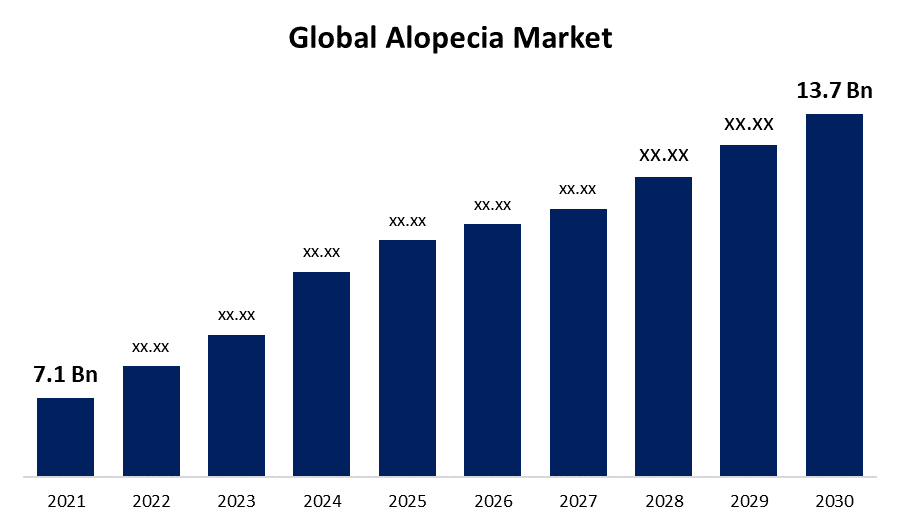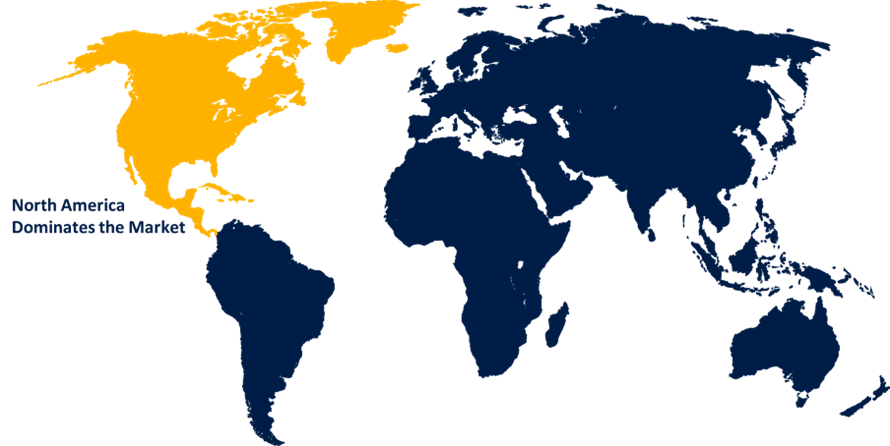Global Alopecia Market Size, Share, and COVID-19 Impact Analysis, By Disease (Alopecia Areata, Androgenetic Alopecia and Others), By Sales Channel (Prescriptions, OTC), By Gender (Male, Female), By End User (Homecare Setting and Dermatology Clinics), By Treatment Type (Pharmaceuticals, Devices), by Region (North America, Europe, Asia-Pacific, Latin America, Middle East, and Africa), Analysis and Forecast 2021 - 2030) Global Alopecia Market Insights Forecasts to 2030
Industry: HealthcareGlobal Alopecia Market Insights Forecasts to 2030
- The Alopecia market was valued at USD 7.1 billion in 2021.
- The market is growing at a CAGR of 7.7% from 2022 to 2030
- The global Alopecia market is expected to reach USD 13.7 billion by 2030
- Asia Pacific is expected to grow the fastest during the forecast period

Get more details on this report -
The global Alopecia market is expected to reach USD 13.7 billion by 2030, at a CAGR of 7.7% during the forecast period 2022 to 2030. Some of the key reasons propelling the market include the rising incidence of chronic disorders linked to hair loss, technological improvements in the treatment of alopecia, and the rising prevalence of alopecia.
Market Overview
Spot baldness is another name for alopecia areata. It is a medical disorder in which all or partial body parts lose their hair. People's scalps frequently develop a few bald spots as a result. Typically, a spot is the size of a penny. The hair on the head or body may occasionally fall off permanently. Alopecia areata is an autoimmune illness brought on by a loss of the hair follicles' immunological privilege. A family history of the same illness increases your risk for developing alopecia areata. The mechanism involves the body's inability to identify its own cells as a result of the hair follicle's loss. There is currently no known treatment for the condition, however various drugs are being explored for regrowth, such as cortisone injections, sunscreen to protect the affected area from the sun and cold, and glasses if eyelashes have been damaged or are absent. In men, this disorder is also known as male-pattern baldness. Another type of androgenetic alopecia is common in both sexes. In this instance, hair loss is clearly specified.
Report Coverage
This research report categorizes the market for Alopecia market based on various segments and regions and forecasts revenue growth and analyzes trends in each submarket. The report analyses the key growth drivers, opportunities, and challenges influencing the Alopecia market. Recent market developments and competitive strategies such as expansion, product launch and development, partnership, merger, and acquisition have been included to draw the competitive landscape in the market. The report strategically identifies and profiles the key market players and analyses their core competencies in each sub-segments of the Alopecia market.
Global Alopecia Market Report Coverage
| Report Coverage | Details |
|---|---|
| Base Year: | 2021 |
| Market Size in 2021: | USD 7.1 Billion |
| Forecast Period: | 2021-2030 |
| Forecast Period CAGR 2021-2030 : | 7.7% |
| 2030 Value Projection: | USD 13.7 Billion |
| Historical Data for: | 2017-2020 |
| No. of Pages: | 200 |
| Tables, Charts & Figures: | 110 |
| Segments covered: | By Disease , By Sales , By Gender , By End User, By Treatment Type , by Region , COVID-19 Impact Analysis |
| Companies covered:: | Sun Pharmaceutical Industries Ltd., Merck & Co., Inc., Cipla Inc.,Johnson and Johnson AG, Lexington International LLC,Transitions Hair Pty Ltd.,Cirrus Hair Centers, Vita-Cos-Med Klett-Loch GmbH, Capillus, Follica, Inc. |
| Growth Drivers: | The increasing prevalence of alopecia is attributed in large part to changing lifestyle habits like excessive alcohol and tobacco consumption as well as rising stress levels. |
| Pitfalls & Challenges: | COVID-19 Empact, Challenge, Future, Growth, & Analysis |
Get more details on this report -
Driving Factors
The increasing prevalence of alopecia is attributed in large part to changing lifestyle habits like excessive alcohol and tobacco consumption as well as rising stress levels. The genetic component is thought to be one of the disease's causes and is connected to multiple occurrences of alopecia, despite the fact that the disease's epidemiology is unknown. Also, the market for alopecia products is anticipated to develop as a result of rising disposable income and a growing emphasis on appearances. Alopecia treatment demand is significantly increased by ageing and abnormalities. Ender also has a significant impact on illness risk. Moreover, the Global Alopecia Market is also influenced by the increasing prevalence of chronic diseases including Polycystic Ovary Disease (PCOD), hyperthyroidism, acute stress disorder, hypothyroidism, cancer, lupus, and hypopituitarism. The Global Alopecia Market is expanding at an accelerated rate due to new medication and technological advances like the emergence of rapid-action JAK inhibitors and hair growth stimulation methods like PRP therapy and pluripotent stem cells.
Restraining Factors
Expanding the use of alternatives like traditional medicines including Ayurvedic, Chinese, and indigenous drugs could hinder the market's expansion.
Market Segmentation
- In 2021, the Alopecia Areata segment is dominating the market with the largest market share.
On the basis of disease type, the Alopecia Market is segmented as Alopecia Areata, Androgenetic Alopecia and Others. Among these, the alopecia areata segment is dominating the market with the largest market share over the forecast period. The high disease frequency around the world and growing consumer awareness of treatments are factors in the increase. Moreover, those with autoimmune diseases are more likely to get alopecia.
- In 2021, the Prescriptions segment to dominate the market with the largest market share over the forecast period.
Based on the sales channel, the global alopecia market is segmented into prescriptions and OTC. Among these, the prescription segment is going to dominate the market over the forecast period. Treatment that is both affordable and effective, the accessibility of therapies, and the rising number of drug approvals are some of the elements that are fueling the expansion of certain markets.
- In 2021, the male segment accounted the largest share over the forecast period.
On the basis of gender, the global alopecia market is categorized into male and female. Among these, the male segment accounted the largest share over the forecast period. The expansion of the male market is being driven by a number of factors, including gender because androgen is the main factor in androgenic alopecia in males as well, the global geriatric population, and an increase in cigarette usage.
- In 2021, the Dermatology segment is dominating the market with the largest market share.
On the basis of end user, the global alopecia market is segmented into Homecare Setting and Dermatology Clinics. Among these, the dermatology segment is dominating the market with the largest market share. Contemporary treatment techniques like laser technology, a robust product pipeline, and increased public awareness of the usage of prescription drugs are the key drivers of the segment's sustained growth. The consulting dermatologist is frequently regarded as the best alternative for treating alopecia due to their capacity to supply appropriate personalised medications or therapy that produce successful outcomes.
- In 2021, the Pharmaceutical segment to dominate the market over the forecast period.
On the basis of treatment type, the global alopecia market is segmented into pharmaceuticals, devices. Among these, the pharmaceuticals segment is going to dominate the market over the forecast period. The segment is primarily driven by the low cost of pharmaceutical items and high consumption of prescription and over-the-counter medications. The two most popular medications for treating alopecia are finasteride and minoxidil. The category is expected to grow throughout the projected period due to the active involvement of large pharmaceutical firms like Lilly, Pfizer Inc., and Concert Pharmaceuticals in the discovery of novel medications to treat alopecia.
Regional Segment Analysis of the Alopecia Market

Get more details on this report -
- North America (U.S., Canada, Mexico)
- Europe (Germany, France, U.K., Italy, Spain, Rest of Europe)
- Asia-Pacific (China, Japan, India, Rest of APAC)
- South America (Brazil and the Rest of South America)
- The Middle East and Africa (UAE, South Africa, Rest of MEA)
North America is dominating the market with the largest market share over the forecast period.
Among all other regions, North America is dominating the market with the largest market share over the forecast period. High disease prevalence, increased consumer awareness, pro-active government actions, technological breakthroughs, and improvements to healthcare infrastructure all contribute to the growth. A major driver of the market's expansion is the existence of important players in this area. Also, the region's treatment rate for alopecia is rising as more people use laser-based therapy to treat the condition.
Recent Developments
- In August 2020, Flu Guard (Favipiravir 200 mg) has been introduced in India at a reasonable price of Rs.35 per tablet for the treatment of mild to moderate Covid-19 patients. Favipiravir is the sole oral antiviral medication authorised for the treatment of individuals with mild to moderate Covid-19 illness in India.
- In February 2021, The long-term care (LTC) division website for Sun Pharmaceutical, www.sunltc.com, has gone live in the US.
- In May 2021, AstraZeneca AB transfers to Sun Pharmaceutical Industries trademarks and patent licences for dapagliflozin and its combinations, as well as modifications to the distribution services contract.
Competitive Analysis:
The report offers the appropriate analysis of the key organizations/companies involved within the global Alopecia market along with a comparative evaluation primarily based on their product offering, business overviews, geographic presence, enterprise strategies, segment market share, and SWOT analysis. The report also provides an elaborative analysis focusing on the current news and developments of the companies, which includes product development, innovations, joint ventures, partnerships, mergers & acquisitions, strategic alliances, and others. This allows for the evaluation of the overall competition within the market.
List of Key Companies
- Sun Pharmaceutical Industries Ltd.
- Merck & Co., Inc.
- Cipla Inc.
- Johnson and Johnson AG
- Lexington International LLC
- Transitions Hair Pty Ltd.
- Cirrus Hair Centers
- Vita-Cos-Med Klett-Loch GmbH
- Capillus
- Follica, Inc.
Key Target Audience
- Market Players
- Investors
- End-users
- Government Authorities
- Consulting And Research Firm
- Venture capitalists
- Value-Added Resellers (VARs)
Market Segment
This study forecasts revenue at global, regional, and country levels from 2019 to 2030. Spherical Insights has segmented the global Alopecia market based on the below-mentioned segments:
Alopecia Market, By Disease Type
- Alopecia Areata
- Androgenetic Alopecia
- Others
Alopecia Market, By Sales Channel
- Prescriptions
- OTC
Alopecia Market, By Gender
- Male
- Female
Alopecia Market, By End User
- Homecare Setting
- Dermatology Clinics
Alopecia Market, By Treatment Type
- Pharmaceuticals
- Devices
Alopecia Market, Regional Analysis
- North America
- US
- Canada
- Mexico
- Europe
- Germany
- Uk
- France
- Italy
- Spain
- Russia
- Rest of Europe
- Asia Pacific
- China
- Japan
- India
- South Korea
- Australia
- Rest of Asia Pacific
- South America
- Brazil
- Argentina
- Rest of South America
- Middle East & Africa
- UAE
- Saudi Arabia
- Qatar
- South Africa
- Rest of Middle East & Africa
Need help to buy this report?